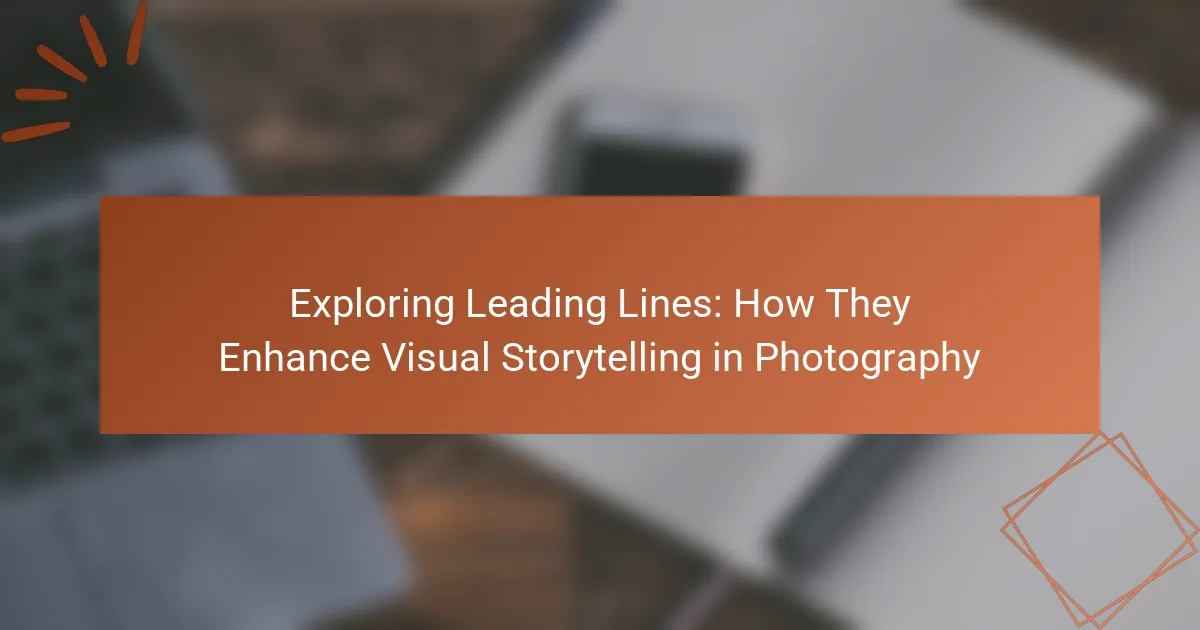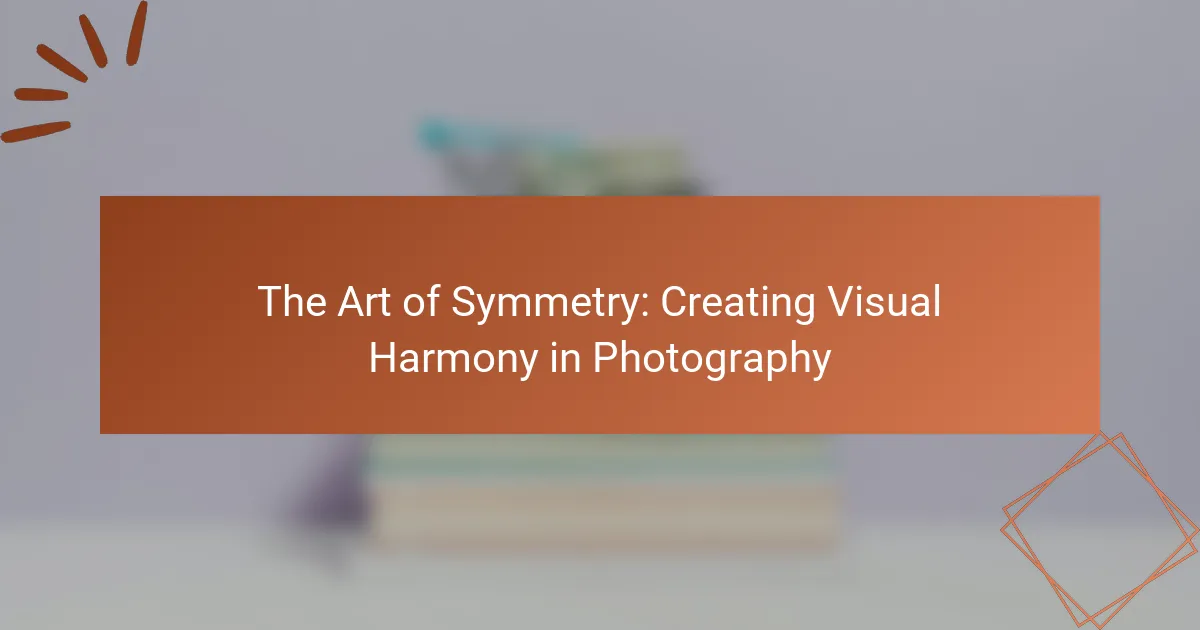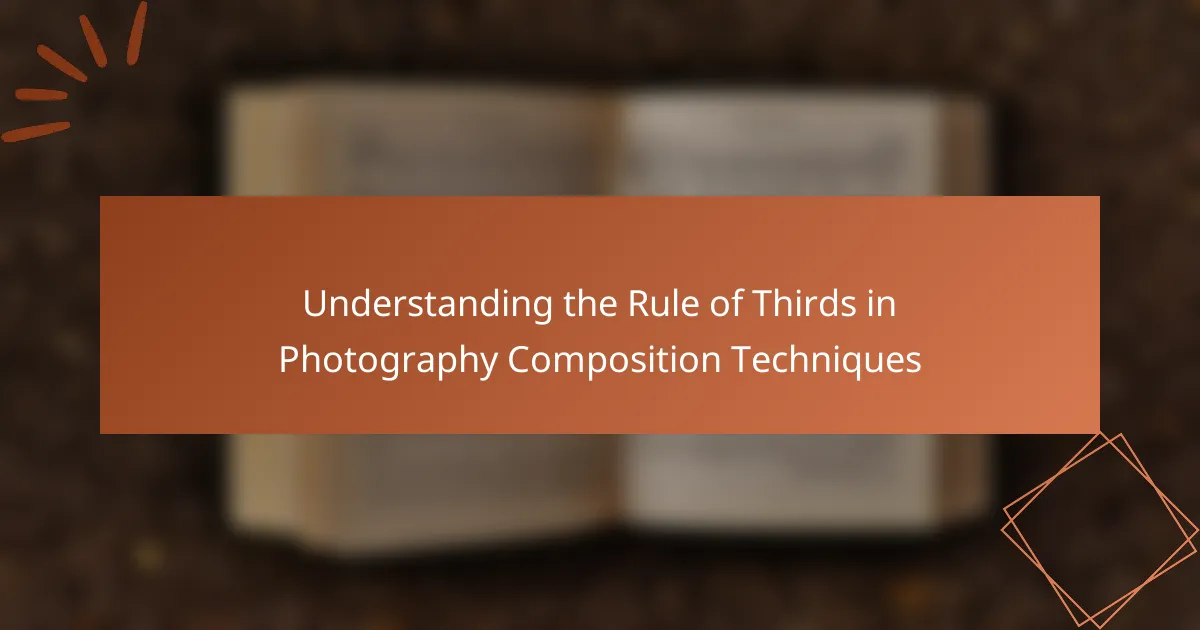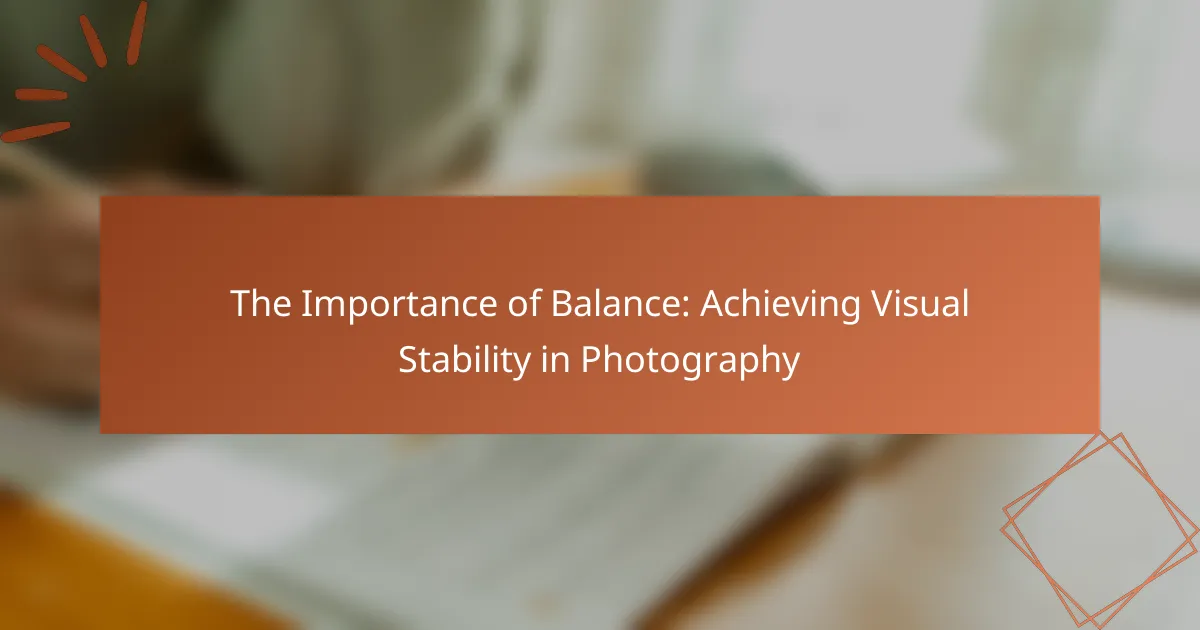Depth of field (DoF) is the distance between the nearest and farthest objects in a photograph that appear acceptably sharp, playing a vital role in photography and cinematography. This article explores the three main types of depth of field—shallow, medium, and deep—each serving distinct artistic purposes and influencing viewer perception. Key factors affecting depth of field include aperture size, focal length, and distance from the subject, which photographers can adjust to achieve desired visual effects. Understanding these principles enables photographers to effectively manipulate depth of field for creative composition, enhancing the focus on subjects while managing background clarity.
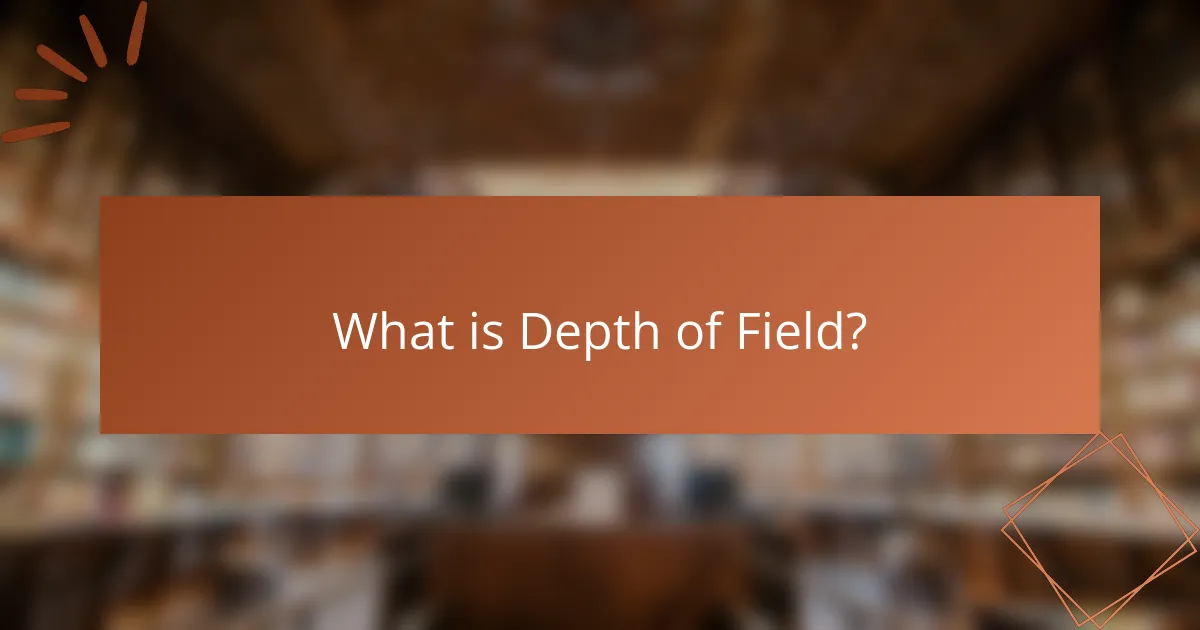
What is Depth of Field?
Depth of field is the distance between the nearest and farthest objects in a photo that appear acceptably sharp. It is a crucial aspect of photography and cinematography. A shallow depth of field results in a blurred background, emphasizing the subject. Conversely, a deep depth of field keeps more of the scene in focus. Factors influencing depth of field include aperture size, focal length, and distance from the subject. A larger aperture (smaller f-number) creates a shallower depth of field, while a smaller aperture increases it. Understanding depth of field helps photographers create desired visual effects and compositions.
How does Depth of Field influence photographic composition?
Depth of Field (DoF) significantly influences photographic composition by controlling the extent of sharp focus in an image. A shallow DoF isolates the subject from the background, creating emphasis and drawing viewer attention. This technique is commonly used in portrait photography to highlight the subject’s features. Conversely, a deep DoF keeps more of the scene in focus, which is beneficial for landscapes and architectural photography. It allows the viewer to appreciate the context and details of the entire scene. The choice of DoF can also affect the mood and narrative of a photograph. For instance, a blurred background can evoke a sense of intimacy, while a sharp background can convey a sense of place. Understanding how to manipulate DoF is essential for effective photographic storytelling.
What are the key factors that determine Depth of Field?
The key factors that determine Depth of Field are aperture, focal length, and distance to the subject. Aperture controls the amount of light entering the lens. A wider aperture (lower f-stop number) results in a shallower depth of field. Conversely, a smaller aperture (higher f-stop number) increases depth of field. Focal length affects perspective and depth of field. Longer focal lengths produce a shallower depth of field, while shorter focal lengths increase it. Distance to the subject also plays a crucial role. The closer the subject is to the camera, the shallower the depth of field becomes. These factors interact to create the desired focus effect in photography.
How does aperture size affect Depth of Field?
Aperture size directly influences depth of field. A larger aperture (smaller f-number) results in a shallower depth of field. This causes a more pronounced blur in the background. Conversely, a smaller aperture (larger f-number) increases the depth of field. This allows more of the scene to be in focus. The relationship is rooted in optics. As the aperture size changes, the amount of light entering the lens also changes. This alters the focus characteristics of the image. Photographers use this principle to control composition and subject isolation.
Why is Depth of Field important in visual storytelling?
Depth of Field (DoF) is crucial in visual storytelling because it guides the viewer’s attention. A shallow DoF isolates the subject, creating emphasis and emotional impact. In contrast, a deep DoF includes more background detail, providing context and depth to the narrative. This control over focus can enhance mood and storytelling by directing viewer perception. For example, filmmakers often use shallow DoF during intimate scenes to evoke closeness. In contrast, wide landscapes may utilize deep DoF to convey vastness. Studies show that effective DoF usage can significantly influence audience engagement and interpretation of a scene.
What role does Depth of Field play in directing viewer attention?
Depth of Field (DoF) plays a crucial role in directing viewer attention by controlling the sharpness of the image. It determines which parts of a scene are in focus and which are blurred. A shallow depth of field isolates the subject from the background. This isolation emphasizes the subject, guiding the viewer’s gaze directly to it. Conversely, a deep depth of field keeps more elements in focus. This approach can create a sense of context but may dilute the viewer’s attention on the main subject. Studies show that viewers naturally focus on areas of sharp detail. Therefore, manipulating DoF effectively enhances storytelling in visual compositions.
How does Depth of Field enhance the emotional impact of an image?
Depth of Field enhances the emotional impact of an image by controlling the focus area within the frame. A shallow depth of field isolates the subject, making it stand out against a blurred background. This technique directs the viewer’s attention to the subject’s emotions and expressions. It creates intimacy and connection, evoking stronger feelings. Conversely, a deep depth of field includes more background detail, providing context but potentially diluting emotional intensity. Studies show that images with shallow depth of field are perceived as more engaging and emotionally resonant. This effect is utilized in portrait photography to emphasize the subject’s feelings.
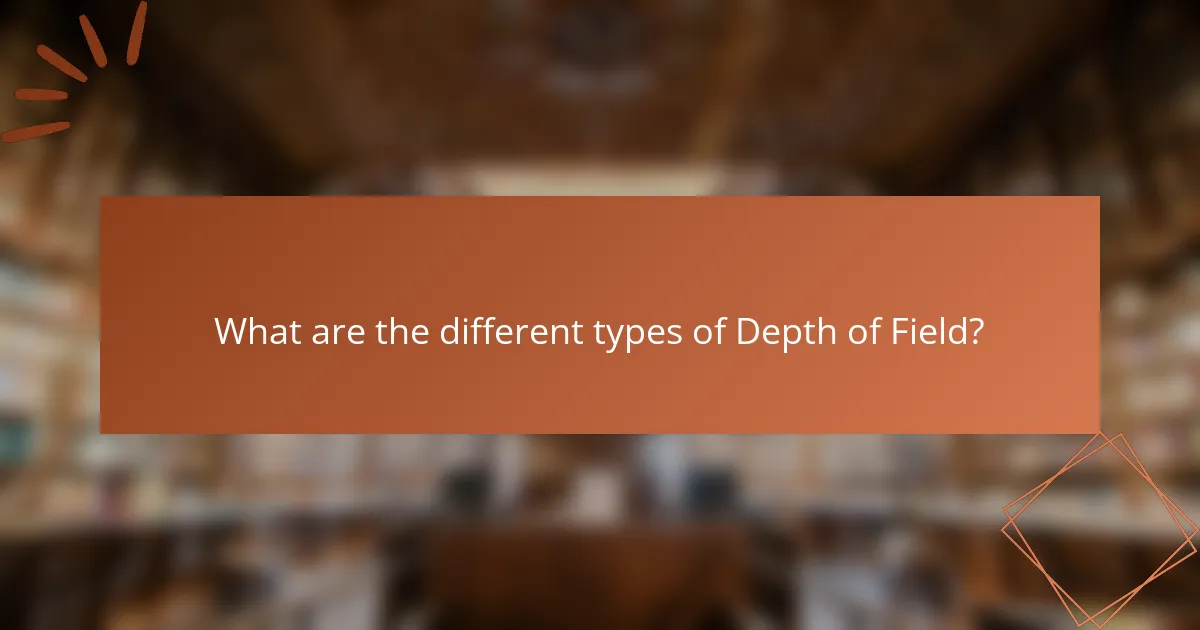
What are the different types of Depth of Field?
There are three main types of depth of field: shallow, medium, and deep. Shallow depth of field focuses on a small area, blurring the background. This technique highlights the subject, often used in portrait photography. Medium depth of field offers a balance between the subject and background clarity. It is commonly used in street photography. Deep depth of field keeps most of the scene in focus, ideal for landscapes. Each type serves different artistic purposes and affects viewer perception.
How do shallow and deep Depth of Field differ?
Shallow depth of field focuses on a small area, blurring the background. This technique isolates the subject, creating a sense of depth. It is often used in portrait photography to emphasize the subject. In contrast, deep depth of field keeps most of the scene in focus. This approach is common in landscape photography, ensuring detail throughout the image. Shallow depth of field typically results from a wide aperture, while deep depth of field arises from a narrow aperture. The difference significantly impacts the visual narrative of the photograph.
What are the creative uses of shallow Depth of Field?
Shallow depth of field is used creatively to isolate subjects from their backgrounds. This technique highlights the main subject by blurring distractions. It enhances emotional impact by drawing viewer attention to specific details. Photographers often use it in portraiture to emphasize [censured] features. In macro photography, it allows for striking close-ups of small subjects. Cinematic visuals benefit from shallow depth of field to create a dreamy atmosphere. It can also guide the viewer’s eye through a composition by controlling focus. These applications are widely recognized in both photography and videography.
When is deep Depth of Field preferred in photography?
Deep depth of field is preferred in photography when the goal is to keep both the foreground and background in sharp focus. This technique is commonly used in landscape photography to capture expansive scenes. It is also beneficial in macro photography, where details in both the subject and its surroundings are important. Additionally, deep depth of field is favored in architectural photography to showcase the entirety of buildings and their context. The use of smaller apertures, such as f/11 or f/16, helps achieve this effect. Research indicates that a greater depth of field enhances viewer engagement by providing a more immersive experience in the image.
What techniques can be used to manipulate Depth of Field?
Techniques to manipulate Depth of Field include adjusting aperture, changing focal length, and altering subject distance. A wider aperture, such as f/1.8, results in a shallower depth of field. This blurs the background, isolating the subject effectively. Conversely, a smaller aperture, like f/16, increases depth of field, keeping more of the scene in focus. Changing the focal length can also impact depth of field. A longer focal length compresses the background, enhancing the bokeh effect. Additionally, moving closer to the subject decreases depth of field, while moving further away increases it. These techniques allow photographers to control focus and background separation.
How can lens choice impact Depth of Field?
Lens choice significantly impacts depth of field (DoF). Different focal lengths and aperture settings influence how much of the scene appears in focus. A longer focal length lens, such as a telephoto lens, typically produces a shallower DoF. This effect isolates subjects from the background, creating a blurred effect. Conversely, a shorter focal length lens, like a wide-angle lens, generally offers a deeper DoF. This allows more elements in the scene to remain in focus. Additionally, wider apertures (lower f-stop numbers) reduce DoF, while narrower apertures (higher f-stop numbers) increase it. Therefore, selecting a lens and its settings directly affects the visual composition and focus within an image.
What are the effects of distance on Depth of Field?
Distance significantly affects Depth of Field (DoF) in photography. As the distance between the camera and the subject increases, the Depth of Field becomes deeper. This means more of the scene will be in focus. Conversely, when the subject is closer to the camera, the Depth of Field narrows, resulting in a blurred background.
This relationship is due to the way light converges through the lens. The closer the subject, the more pronounced the focus fall-off is. For example, at a distance of 1 meter, a lens may have a shallow DoF, while at 10 meters, it may encompass a broader area in focus.
Photographers often use this principle to create artistic effects. By adjusting the distance to the subject, they can manipulate the focus and background blur. This technique is essential for achieving specific compositional goals in photography.

How can photographers effectively use Depth of Field?
Photographers can effectively use Depth of Field (DoF) by adjusting aperture, focal length, and distance to the subject. A wide aperture (small f-number) creates a shallow DoF, isolating the subject from the background. This technique is ideal for portraits, as it emphasizes the subject. Conversely, a narrow aperture (large f-number) increases DoF, bringing more elements into focus. This is useful in landscape photography, where detail throughout the scene is desired. Additionally, using longer focal lengths can compress the background, enhancing the effect of shallow DoF. Photographers should also consider their distance from the subject; closer proximity results in a shallower DoF. Understanding these principles allows photographers to manipulate DoF for creative composition.
What are best practices for achieving desired Depth of Field?
To achieve the desired Depth of Field (DoF), use a wide aperture setting. A wider aperture, such as f/1.8 or f/2.8, creates a shallow DoF, blurring the background. Conversely, a smaller aperture, like f/11 or f/16, increases the DoF, keeping more of the scene in focus.
Additionally, the distance from the subject affects DoF. Closer proximity to the subject results in a shallower DoF. Conversely, increasing the distance enhances the DoF.
Using a longer focal length lens also contributes to a shallower DoF. For example, a 85mm lens produces a different effect than a 24mm lens at the same aperture.
Furthermore, consider the sensor size. Larger sensors, such as full-frame sensors, generally produce a shallower DoF compared to smaller sensors.
These techniques are widely recognized in photography and can be found in resources like “Understanding Exposure” by Bryan Peterson.
How should one select aperture settings for optimal Depth of Field?
To select aperture settings for optimal depth of field, choose a smaller aperture (higher f-stop number) for greater depth of field. A smaller aperture increases the range of distance in which objects appear sharp. For example, f-stops like f/8 or f/11 are commonly used for landscapes to keep foreground and background in focus. Conversely, a larger aperture (lower f-stop number) like f/2.8 creates a shallow depth of field, isolating the subject from the background. This technique is effective for portraits, emphasizing the subject while blurring distractions. The choice of aperture also depends on the lens characteristics and the desired artistic effect. Adjusting the aperture impacts exposure, so consider the lighting conditions when making your selection.
What tips can help in composing images with balanced Depth of Field?
Use a wide aperture for a shallow depth of field. This technique blurs the background and emphasizes the subject. Conversely, a narrow aperture increases depth of field, keeping more elements in focus. Adjust your distance from the subject to manipulate depth of field effectively. The closer you are, the shallower the depth of field becomes. Utilize a full-frame camera if possible, as it provides better control over depth of field. Consider the focal length of your lens; longer lenses create a shallower depth of field. Lastly, use focus stacking for landscapes to achieve sharpness throughout the image. This method combines multiple images taken at different focus points.
What common mistakes should be avoided when working with Depth of Field?
Common mistakes to avoid when working with Depth of Field include using an inappropriate aperture setting. A wide aperture can lead to excessive blur in the background, losing important context. Conversely, a narrow aperture may cause too much of the scene to be in focus, detracting from the subject. Another mistake is neglecting the distance between the subject and the background. Close proximity can exaggerate blur, while distance can minimize it. Failing to consider the sensor size is also critical. Larger sensors create shallower Depth of Field at the same aperture compared to smaller sensors. Additionally, not understanding the impact of focal length can lead to miscalculations in focus. Longer focal lengths compress the background, affecting perceived Depth of Field. Finally, overlooking the effects of camera movement can result in unintended focus shifts. Proper stabilization is essential for maintaining desired focus.
How can improper Depth of Field affect image quality?
Improper depth of field can significantly degrade image quality. It can lead to unwanted areas being in focus or out of focus. This misalignment can distract viewers from the intended subject. For instance, if the background is sharply focused, it competes with the main subject. Conversely, if the subject is blurred while the background is clear, it can confuse the viewer. The desired aesthetic effect is compromised, resulting in a less impactful image. Studies show that optimal depth of field enhances clarity and visual appeal. Thus, achieving the correct depth of field is crucial for high-quality photography.
What are the signs of overusing Depth of Field in photography?
Overusing Depth of Field in photography can lead to several noticeable signs. One sign is the excessive blurriness of backgrounds that distracts from the main subject. When backgrounds are too blurred, they can create confusion about the focal point. Another sign is the loss of context, where important elements are rendered indistinct. This can hinder the viewer’s understanding of the scene. Additionally, overuse may result in a flat appearance, where images lack depth and dimension. This occurs when all elements seem equally sharp or soft without a natural gradient. Furthermore, if every image consistently employs shallow depth of field, it may indicate a lack of variety in compositional techniques. This repetitiveness can make a portfolio feel monotonous. Therefore, recognizing these signs can help photographers achieve a more balanced use of depth of field.
Depth of field (DoF) is the distance between the nearest and farthest objects in a photograph that appear acceptably sharp, influencing photographic composition and storytelling. This article explores the factors that determine DoF, including aperture size, focal length, and subject distance, and explains how these elements can be manipulated to achieve desired visual effects. It covers the different types of depth of field—shallow, medium, and deep—and discusses their creative applications in various photography genres. Additionally, the article highlights best practices for achieving optimal depth of field, common mistakes to avoid, and the impact of improper DoF on image quality.
